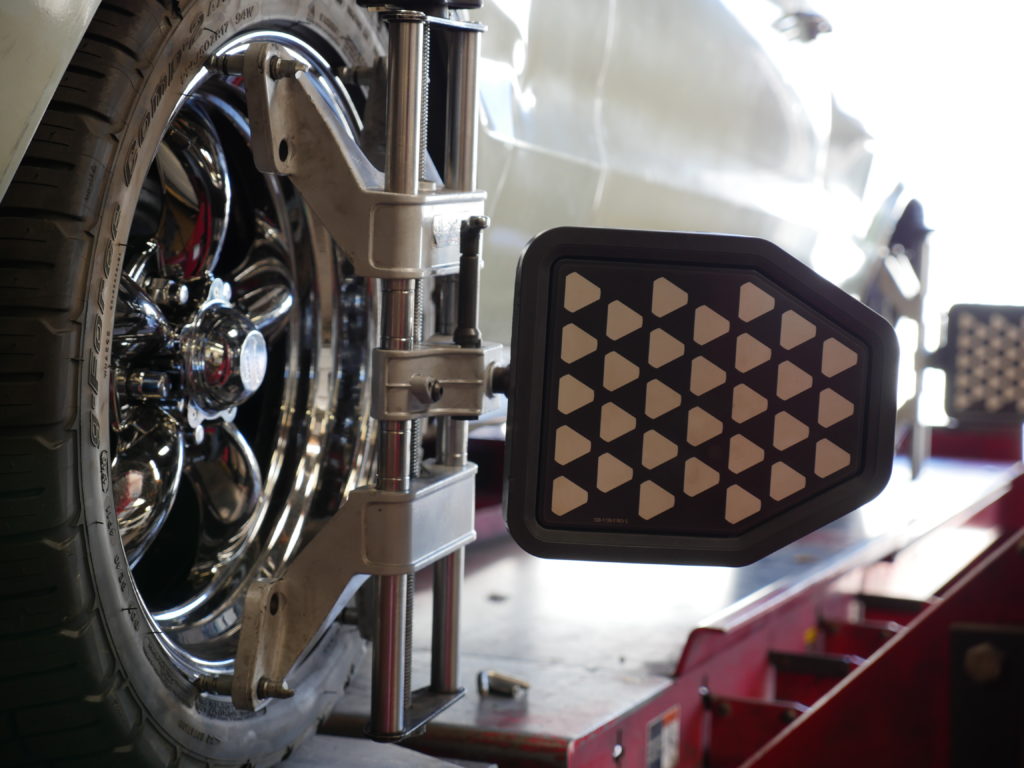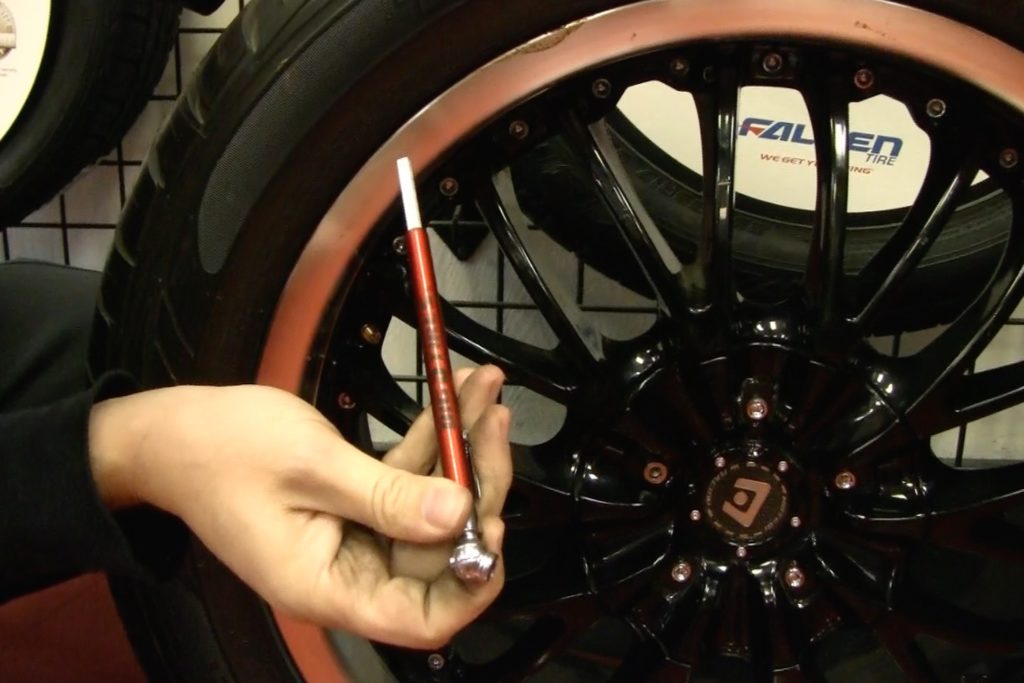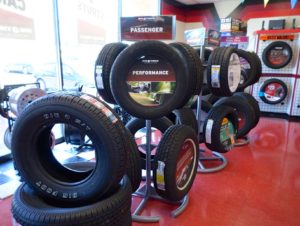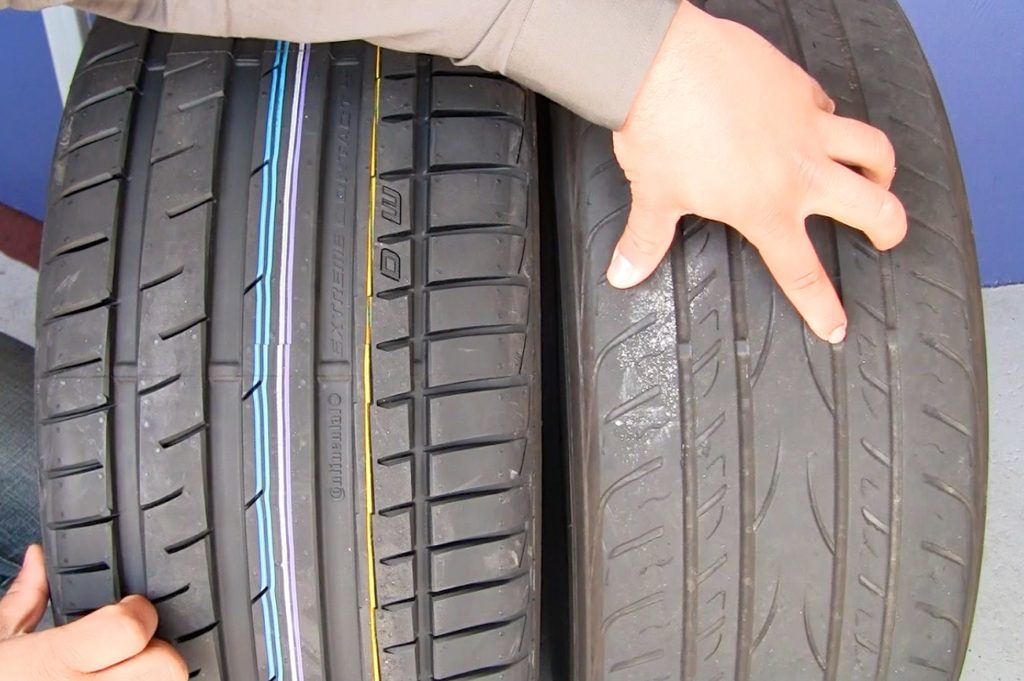
There’s a lot more to tire care than you may realize. Photo: Big O Tires – Pleasanton ©2018
Want to get the most out of your vehicle’s tires? Of course you do. However, you may not realize all that this entails in terms of ongoing care and maintenance. To help you, we’ve created this comprehensive, “rubber meets the road” guide to tire care. In it, we’ll cover the following aspects:
- Why tire care is important
- Maintaining proper tire pressure
- Rotating your tires
- Wheel alignment and balance
- Tire repair
- Knowing when to replace your tires
Ready to expand your knowledge? Let’s get rolling!
Why is tire care important?
There are many reasons why it’s important to care for your tires. Here are four of the big ones:
- Safety – Tires are designed to provide traction and “grab” the road, but when worn-down, they’re unable to function as intended. This can put you at a greater risk of losing control of your vehicle, especially when driving on wet or icy roads.
- Tire lifespan – According to Walee Gon of Faxon Garage in San Francisco, when tires are under-inflated, it can lower their lifespan as much as 20 percent. Failing to regularly rotate your tires or realign your wheels also leads to accelerated wear. The result: you’ll have to replace your tires more often, which gets expensive.
- Fuel economy – When your tires are under-inflated or in poor condition, it reduces your vehicle’s fuel economy, which means you’ll pay more for gas over the long term.
- Braking and handling – Worn-out or under-inflated tires make for slower braking time and subpar vehicle handling. Not only is this detrimental to safety and tire lifespan, it also detracts from your overall driving experience.

Rule #1 of tire care: Maintain proper tire pressure. Photo: Big O Tires – Pleasanton ©2018
Maintaining proper tire pressure
The most basic component of tire care is keeping your tires at the proper inflation level. While your vehicle’s dashboard will alert you when tire pressure is low, it’s better to check your tires proactively than to wait for a warning light to turn on. A good rule is to check your tires’ pressure once a week and add air as needed to maintain the desired level. It’s not a difficult task, but you do need to know what you’re doing.
Tire pressure is measured by pounds per square inch (PSI). Don’t worry, you won’t have to do any math—all you need is a tire pressure gauge, which you can buy at any auto supply store. Unscrew the cap on the tire’s valve stem and press the end of the gauge onto it. Don’t be startled when you hear a loud “PSST!” sound—that’s just the gauge measuring the pressure. If the tire’s PSI level is low, add some air and measure again.
But how do you know the correct PSI for your tires? You can find this in a couple of places. Usually, the manufacturer-recommended PSI is printed on the informational sticker on your vehicle’s driver’s side door jamb; if you can’t find it there, consult your vehicle owner’s manual. One place you should not look is on the tire itself. The number printed on the tire represents the maximum PSI that’s safe to drive with. While it’s not unsafe to fill your tires to this level, your vehicle will not perform as well and your tires’ center tread will wear faster.
Josh Cherry of Big O Tires – Pleasanton gives some additional advice for tire inflation. “When inflating your tires at a gas station, be sure to use your own gauge for checking tire pressure, as gas station gauges aren’t always accurate. Also, if possible, consider filling your tires with nitrogen rather than regular air. Since it’s a denser molecule that doesn’t contain or support moisture, nitrogen doesn’t fluctuate as much as air, which makes it better for gas mileage and tire lifespan.”
Traditionally, tire pressure gauges have been strictly analog, but over the last few decades, digital gauges have come onto the scene. So, which is better? Let’s look at the specific advantages of each option:
- Analog tire pressure gauges (whether pencil or dial-style) are simple and often more durable due to their lack of electronic components. Also, they don’t require batteries like digital gauges do.
- Digital tire pressure gauges are accurate and easy to read, and many offer additional features that analog gauges don’t have.
At the end of the day, the choice comes down to your personal preference. However, whichever style you prefer, it’s important to find a quality, accurate gauge, so don’t just choose the cheapest one. Consult consumer reports for recommendations on a good product that fits your budget.
Rotating your tires
Another critical aspect of tire care is rotating your tires at routine intervals. Due to the difference in weight on your vehicle’s front and rear axles, one set of tires will gradually wear faster than the other if not rotated regularly. Rotating your tires twice a year or every 6,000 to 8,000 miles will ensure they wear evenly over time.
Many tire suppliers and auto repair shops offer free tire rotations to their customers; otherwise, this service typically costs between $25 and $50, depending on where you go. Alternately, you can opt to perform it yourself, as many vehicle owners do. However, while tire rotation may seem like a relatively simple task, it’s important to know what you’re doing.
First, you need to ensure safety. Make sure you have the correct tools to jack up your vehicle and know how to do it correctly. You’ll also need a jack stand to hold up the vehicle while you move the tires around; however, a spare tire can also serve this purpose.

Tire rotation is another critical aspect of tire care. Photo: Big O Tires – Pleasanton ©2018
Next, you’ll need to determine the correct tire rotation pattern, which can vary depending on the characteristics of your vehicle and your tires. For example, if you have a front-wheel drive vehicle with equally sized, non-directional tires (i.e. most small to mid-sized cars), you’ll employ a “forward cross” pattern: the rear tires move diagonally to the front, while the front set go straight to the back without changing sides. By contrast, if you have an all- or rear-wheel drive vehicle, you’ll do the opposite, employing a “rearward cross” pattern, where the front tires move diagonally to the rear and the rear tires move to the front without changing sides. Note that in both instances an alternative “X” pattern may be used, where each tire moves to the diagonal position.
Some types of tires and vehicles require unique tire rotation patterns. For example, if you have directional tires (which have a tread pattern that’s optimized for a specific direction) or tires that differ in size, you can only rotate them front-to-back or side-to-side, respectively. Furthermore, dually trucks (which have dual rear wheels on each side) have their own specific tire rotation pattern. Be sure to confirm the correct pattern for your vehicle/tires before attempting to rotate tires yourself.
Wheel alignment and balance
Even when routinely rotated, tires can wear irregularly due to misaligned or imbalanced wheels. Wheel alignment and balance are often conflated, but they actually pertain to two distinct aspects of driving. Wheel alignment consists of adjusting the wheel angles so they’re perpendicular to the ground and parallel to each other. This enables the vehicle to drive straight with minimal additional steering. If you find yourself needing to apply more weight to one side of your steering wheel, or if your vehicle drifts off course as soon as you let go of the wheel, the alignment is most likely off. Over time, this will cause your tires to wear unevenly, so be sure to address the issue as soon as possible.
- Do you feel a lot of vibration when you drive? You probably need a wheel balance.
- Does your steering wheel pull to one side, causing your vehicle to “drift” off course when you let go of it? You probably need a wheel alignment.
Wheel balance, on the other hand, helps maintain a smooth ride. If you notice a lot of vibrations while driving, your wheels probably need to be balanced. Over time, unbalanced wheels can cause “cupping” (a specific type of uneven tread wear) throughout the tires. Keep in mind that cupping can also occur as a result of worn suspension components like shocks and struts, which may allow the tires to bounce more than they should.
While the symptoms of misaligned or imbalanced wheels are often easy to spot, rather than waiting for them to occur, it’s better to be proactive by having your vehicle’s alignment and balance regularly inspected.
Tire repair
Even if you’re diligent about tire care, one thing you can’t do much to prevent is a flat tire. While this can result from a faulty tire component (valve stems are common culprits), a more frequent cause is running over sharp objects like screws or nails. Fortunately, this type of damage can often be easily repaired by patching or plugging the tire.
The simplest option for repairing a punctured tire is taking it to your local auto technician. Patching/plugging a tire is fast and inexpensive—plus, your technician will be able to assess the damage, decide which repair option will work best and let you know how soon you’ll likely need to replace the tire. However, you can also repair your tire with a DIY kit—just make sure you know what you’re doing. Performing an incorrect tire repair will just result in more problems in the future, and it may even require premature replacement.

The simplest way to know if a tire needs to be replaced is to look at the tread wear indicators. Photo: Faxon Garage ©2018
Knowing when to replace your tires
Even if you didn’t run over a screw, it can be surprisingly difficult to tell when your tires need to be replaced. That’s because the difference between a worn-out tire and a good one isn’t always obvious to the untrained eye. Fortunately, there are a couple of simple, unambiguous ways to determine if it’s time for a replacement.
The simplest way is to look for the tread wear indicators. All tires sold in the United States have wear indicators built into the tread. With a new tire, the indicator is recessed deep inside the tread; as the tire wears, the indicator will gradually become visible. When the indicator is flush with the tread, you know it’s time for a replacement.
Another easy method for assessing tire tread is known as the “penny test.” Simply take a penny and place it between the center tread with President Lincoln’s head downward. If the tread is still covering Lincoln’s head, the tire is OK; if his head is completely visible, it’s time for a replacement. To learn more about when to replace your tires, read this article.
